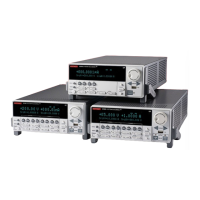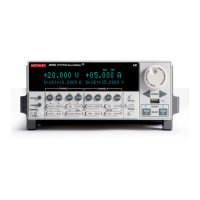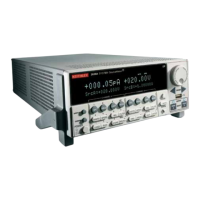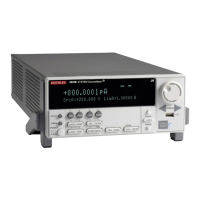System SourceMeter® Instrument Reference Manual Section 7:
2600BS-901-01 Rev. C / August 2016 7-41
A Boolean flag; this flag is true when the pulse was successfully configured, false when
errors were encountered
A string message; if the f flag is false, msg contains an error message; if it is true, msg
contains a string indicating successful configuration
System SourceMeter
®
instrument channel (for example, smua refers to SMU channel A)
Pulse sweep start level in amperes
Pulse sweep stop level in amperes
Voltage limit (for example, compliance) in volts
Pulse on time in seconds
Pulse off time in seconds
Number of pulse-measure cycles
Reading buffer where pulsed measurements will be stored; if this is nil when the function is
called, no measurements will be made when the pulse train is initiated
Numeric identifier to be assigned to the defined pulse train
Defines a digital I/O trigger input line; if programmed, the pulse train waits for a trigger input
before executing each pulse
Defines a digital I/O trigger output line; if programmed, the pulse train generates a trigger
output immediately before the start of
ton
Specifies the length of time (in seconds) to wait for input trigger; default value is 10 s
Specifies whether or not to abort pulse if input trigger is not received; if pulse aborts because
of a missed trigger, a timer timeout message is returned; true or false
Details
Data for pulsed voltage measurements are stored in the reading buffer specified by the buffer input
parameter.
This function configures a logarithmic pulsed current sweep with a voltage measurement at each
point. Measurements are made at the end of the ton time.
The magnitude of the first pulse will be start amperes; the magnitude of the last pulse will be stop
amperes. The magnitude of each pulse in between will be LogStep
n
amperes larger than the
previous pulse, where:
LogStepSize = (log10(stop) - log10(start)) / (points -1)
LogStepn = (n - 1) * (LogStepSize), where n = [2, points]
SourceStepLeveln = antilog(LogStepn) * start
This function does not cause the specified smu to output a pulse train. It simply checks to see if all of
the pulse dimensions can be achieved, and if they can, assigns the indicated tag or index to the
pulse train. The InitiatePulseTest(tag) and InitiatePulseTestDual(tag1, tag2)
functions are used to initiate a pulse train assigned to a valid tag.
